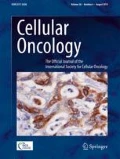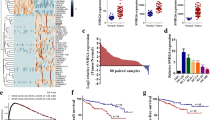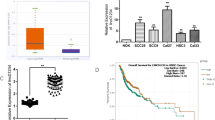Abstract
Purpose
Previously, we found that long non-coding RNA (lncRNA) MEG3 may act as a tumour suppressor in retinoblastoma. Overall, however, little is known about the role of lncRNAs in retinoblastoma. Here, we aimed to determine the expression and clinical significance of lnc00152 in retinoblastoma.
Methods
Lnc00152 and its downstream targets were selected using GEO datasets. The level of lnc00152 in primary patient samples was determined using RT-qPCR. Odds ratios of invasion and metastasis were calculated using logistic regression analysis. Recurrence-free survival was assessed using Cox regression analysis. Scratch wound healing, transwell and tumorigenesis assays were used to determine migration and invasion abilities of retinoblastoma cells in vitro and in vivo. Levels of EMT-related proteins were measured using Western blotting. Binding sites between lnc00152 and its targets were validated using dual-luciferase reporter and RNA pull-down assays. Lnc00152 activating transcription factors were determined using ChIP assays.
Results
We found that Lnc00152 was significantly up-regulated in retinoblastoma tumour tissues, and was a risk factor for tumour invasion, metastasis and recurrence. Lnc00152 overexpressing retinoblastoma cells exhibited a tendency to transform into mesenchymal cells, with significantly increased migration and invasion capacities, significantly decreased E-cadherin expression levels, and significantly increased N-cadherin, SOX9 and ZEB2 expression levels. In addition, we found that lnc00152, which was activated by Sp1, could inhibit miR-30d as an endogenous miRNA ‘sponge’, thereby regulating the expression of SOX9 and ZEB2.
Conclusions
Our data indicate that Lnc00152 may be associated with retinoblastoma invasion, metastasis and prognosis. In addition, we conclude that Lnc00152, which can be activated by Sp1, can induce EMT via the miR-30d/SOX9/ZEB2 pathway and, by doing so, promote the invasion and metastasis of retinoblastoma cells.









Similar content being viewed by others
References
F. Ghassemi, A. Khodabande, Risk definition and management strategies in retinoblastoma: current perspectives. Clin Ophthalmol 9, 985–994 (2015)
N. Cassoux, L. Lumbroso, C. Levy-Gabriel, I. Aerts, F. Doz, L. Desjardins, Retinoblastoma: Update on Current Management. Asia Pac J Ophthalmol (Phila) 6, 290–295 (2017)
J. Gao, J. Zeng, B. Guo, W. He, J. Chen, F. Lu, D. Chen, Clinical presentation and treatment outcome of retinoblastoma in children of South Western China. Medicine (Baltim). 95, e5204 (2016)
J. Zhang, T. Yao, Y. Wang, J. Yu, Y. Liu, Z. Lin, Long noncoding RNA MEG3 is downregulated in cervical cancer and affects cell proliferation and apoptosis by regulating miR-21. Cancer Biol Ther 17, 104–113 (2016)
J. Hu, Y. Shan, J. Ma, Y. Pan, H. Zhou, L. Jiang, L. Jia, LncRNA ST3Gal6-AS1/ST3Gal6 axis mediates colorectal cancer progression by regulating α-2,3 sialylation via PI3K/Akt signaling. Int J Cancer 145, 450–460 (2019)
S. Lingadahalli, S. Jadhao, Y.Y. Sung, M. Chen, L. Hu, X. Chen, E. Cheung, Novel lncRNA LINC00844 regulates prostate cancer cell migration and invasion through AR signaling. Mol Cancer Res 16, 1865–1878 (2018)
L. Wei, X. Wang, L. Lv, Y. Zheng, N. Zhang, M. Yang, The emerging role of noncoding RNAs in colorectal cancer chemoresistance. Cell Oncol 42, 757–768 (2019)
S. Chen, S. Nagel, B. Schneider, H. Dai, R. Geffers, M. Kaufmann, C. Meyer, C. Pommerenke, K.S. Thress, J. Li, H. Quentmeier, H.G. Drexler, R.A.F. MacLeod, A new ETV6-NTRK3 cell line model reveals MALAT1 as a novel therapeutic target - a short report. Cell Oncol 41, 93–101 (2018)
J. Zhang, Y. Gao, Long non-coding RNA MEG3 inhibits cervical cancer cell growth by promoting degradation of P-STAT3 protein via ubiquitination. Cancer Cell Int 19, 175 (2019)
R. Castro-Oropeza, J. Melendez-Zajgla, V. Maldonado, K. Vazquez-Santillan, The emerging role of lncRNAs in the regulation of cancer stem cells. Cell Oncol 41, 585–603 (2018)
J. Zhang, Z. Lin, Y. Gao, T. Yao, Downregulation of long noncoding RNA MEG3 is associated with poor prognosis and promoter hypermethylation in cervical cancer. J Exp Clin Cancer Res 36, 5 (2017)
J. Zhang, T. Yao, Z. Lin, Y. Gao, Aberrant methylation of MEG3 functions as a potential plasma-based biomarker for cervical cancer. Sci Rep 7, 6271 (2017)
P. Dasgupta, P. Kulkarni, S. Majid, V. Shahryari, Y. Hashimoto, N.S. Bhat, M. Shiina, G. Deng, S. Saini, Z.L. Tabatabai, S. Yamamura, Y. Tanaka, R. Dahiya, MicroRNA-203 inhibits long noncoding RNA HOTAIR and regulates tumorigenesis through epithelial-to-mesenchymal transition pathway in renal cell carcinoma. Mol Cancer Ther 17, 1061–1069 (2018)
Y. Gao, X. Lu, Decreased expression of MEG3 contributes to retinoblastoma progression and affects retinoblastoma cell growth by regulating the activity of Wnt/β-catenin pathway. Tumour Biol 37, 1461–1469 (2016)
Y. Gao, P. Huang, J. Zhang, Hypermethylation of MEG3 promoter correlates with inactivation of MEG3 and poor prognosis in patients with retinoblastoma. J Transl Med 15, 268 (2017)
Y. Liu, M. Xue, S. Du, W. Feng, K. Zhang, L. Zhang, H. Liu, G. Jia, L. Wu, X. Hu, L. Chen, P. Wang, Competitive endogenous RNA is an intrinsic component of EMT regulatory circuits and modulates EMT. Nat Commun 10, 1637 (2019)
J.G.M. van Kampen, O. van Hooij, C.F. Jansen, F.P. Smit, P.I. van Noort, I. Schultz, R.Q.J. Schaapveld, J.A. Schalken, G.W. Verhaegh, miRNA-520f reverses epithelial-to-mesenchymal transition by targeting ADAM9 and TGFBR2. Cancer Res 77, 2008–2017 (2017)
Y. Cheng, Q. Chang, B. Zheng, J. Xu, H. Li, R. Wang, LncRNA XIST promotes the epithelial to mesenchymal transition of retinoblastoma via sponging miR-101. Eur J Pharmacol 843, 210–216 (2019)
G. Yang, Y. Fu, X. Lu, M. Wang, H. Dong, Q. Li, LncRNA HOTAIR/miR-613/c-met axis modulated epithelial-mesenchymal transition of retinoblastoma cells. J Cell Mol Med 22, 5083–5096 (2018)
T. Li, H. Huang, G. Shi, L. Zhao, T. Li, Z. Zhang, R. Liu, Y. Hu, H. Liu, J. Yu, G. Li, TGF-β1-SOX9 axis-inducible COL10A1 promotes invasion and metastasis in gastric cancer via epithelial-to-mesenchymal transition. Cell Death Dis 9, 849 (2018)
H. Li, B.G. Mar, H. Zhang, R.V. Puram, F. Vazquez, B.A. Weir, W.C. Hahn, B. Ebert, D. Pellman, The EMT regulator ZEB2 is a novel dependency of human and murine acute myeloid leukemia. Blood 129, 497–508 (2017)
P. Balcik-Ercin, M. Cetin, I. Yalim-Camci, G. Odabas, N. Tokay, A.E. Sayan, T. Yagci, Genome-wide analysis of endogenously expressed ZEB2 binding sites reveals inverse correlations between ZEB2 and GalNAc-transferase GALNT3 in human tumors. Cell Oncol 41, 379–393 (2018)
Z.P. Chen, J.C. Wei, Q. Wang, P. Yang, W.L. Li, F. He, H.C. Chen, H. Hu, J.B. Zhong, J. Cao, Long non–coding RNA 00152 functions as a competing endogenous RNA to regulate NRP1 expression by sponging with miRNA–206 in colorectal cancer. Int J Oncol 53, 1227–1236 (2018)
L. Salmena, L. Poliseno, Y. Tay, L. Kats, P.P. Pandolfi, A ceRNA hypothesis: the Rosetta Stone of a hidden RNA. language? Cell 146, 353–358 (2011)
J. Chen, Y. Yu, H. Li, Q. Hu, X. Chen, Y. He, C. Xue, F. Ren, Z. Ren, J. Li, L. Liu, Z. Duan, G. Cui, R. Sun, Long non-coding RNA PVT1 promotes tumor progression by regulating the miR-143/HK2 axis in gallbladder cancer. Mol Cancer 18, 33 (2019)
Y.H. Tang, G.L. He, S.Z. Huang, K.B. Zhong, H. Liao, L. Cai, Y. Gao, Z.W. Peng, S.J. Fu, The long noncoding RNA AK002107 negatively modulates miR-140-5p and targets TGFBR1 to induce epithelial-mesenchymal transition in hepatocellular carcinoma. Mol Oncol 13, 1296–1310 (2019)
L. Sheng, J. Wu, X. Gong, D. Dong, X. Sun, SP1-induced upregulation of lncRNA PANDAR predicts adverse phenotypes in retinoblastoma and regulates cell growth and apoptosis in vitro and in vivo. Gene 668, 140–145 (2018)
Acknowledgements
The project was supported by the National Natural Science Foundation of China (Grant No. 81902751 and Grant No. 81971385) and the Guangdong Natural Science Foundation (Grant No. 2018A0303100021 and Grant No. 2019A1515010412).
Author information
Authors and Affiliations
Corresponding author
Ethics declarations
All procedures performed in studies involving human participants were in accordance with the standards of the ethic committee of the Shenzhen People’s Hospital. All patients signed inform consent forms.
Conflict of interest
All authors declare that they have no conflict of interest to declare.
Additional information
Publisher's Note
Springer Nature remains neutral with regard to jurisdictional claims in published maps and institutional affiliations.
Rights and permissions
About this article
Cite this article
Gao, Y., Luo, X. & Zhang, J. Sp1-mediated up-regulation of lnc00152 promotes invasion and metastasis of retinoblastoma cells via the miR-30d/SOX9/ZEB2 pathway. Cell Oncol. 44, 61–76 (2021). https://doi.org/10.1007/s13402-020-00522-8
Accepted:
Published:
Issue Date:
DOI: https://doi.org/10.1007/s13402-020-00522-8




